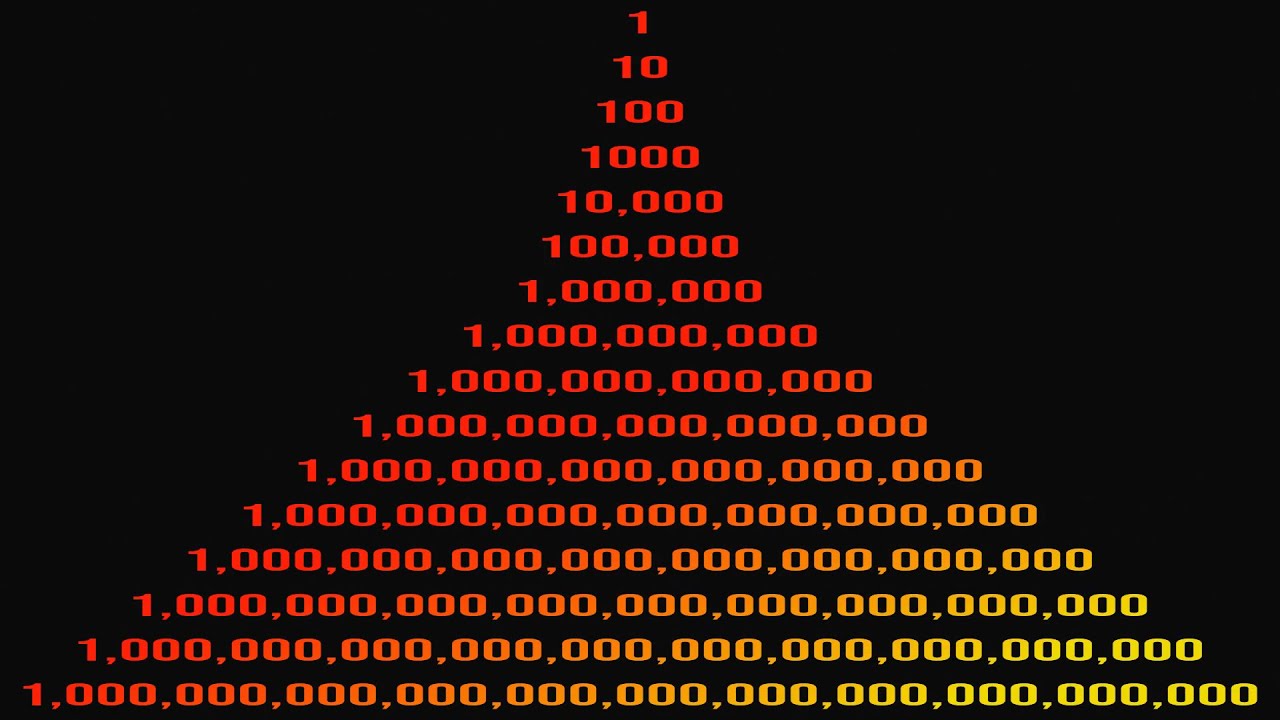Zillion is supposed to be infinite, despite having a set number of zeros.
Have you ever wondered about the sheer magnitude of numbers and their intricate patterns?
As we explore the vast expanse of numerical values, we encounter terms like million, billion, trillion, and beyond. Each of these terms signifies a progressively larger scale, with a corresponding increase in the number of zeros, The term “zillion” is often used informally to represent an extremely large, unspecified number. It’s not a specific numerical value, so it doesn’t have a fixed number of zeros. It’s more of a placeholder for a very large, undefined quantity.
Here, you will unravel the fascinating patterns behind these massive numbers
What role does the digit zero play in counting very large numbers?
Positional Indicator: In our numbering system, each digit’s position determines its significance in the number. For instance, in the number “302,” the first digit “3” signifies three hundred, the second digit “0” indicates zero tens, and the third digit “2” represents two ones. The presence of zero in the tens place ensures the correct value representation.
Placeholder: Zero acts as a placeholder for empty positions. In the number “204,” the zero in the tens place signifies the absence of tens. It maintains the positional value without which the number’s interpretation would be inaccurate.
Scaling by Powers of Ten: Zero facilitates scaling numbers by powers of ten. As numbers grow, they increase by tenfold (10, 100, 1000, etc.). Each increase involves adding more zeros to the number. For example, transitioning from 100 to 1000 entails adding two zeros, reflecting the shift from hundreds to thousands.
Multiples of Ten: Zero represents multiples of ten in large numbers. Each time you multiply by ten, an additional zero is appended. Going from 100 to 1000 involves multiplying by ten and adding one zero.
Enhancing Readability: Zeros group digits for improved readability in large numbers. For instance, 1,000,000 is easier to read than 1000000.
Magnitude Indicator: The count of zeros in a number reveals its order of magnitude. A number with six zeros (1,000,000) is in the millions range, whereas a number with nine zeros (1,000,000,000) belongs to the billions category.
Variations in Terminology for Million and Billion:

The terminology for large numbers like “million” and “billion” can vary across countries and fields such as science and finance. In the United States and much of the world, the “short scale” is prevalent. According to this scale, a billion is understood as 1,000 million. This is represented by a one followed by nine zeros (1,000,000,000).
However, an alternate system known as the “long scale” is used in countries like France and was historically used in the United Kingdom. According to the long scale, a billion signifies one million million. In this context, a billion is represented by a one followed by twelve zeros (1,000,000,000,000).
This distinction between the short and long scales was introduced by the French mathematician Geneviève Guitel in 1975. These differing scales are important to consider, as they ensure clarity and precision when communicating about large numbers on a global scale.
Numbers With Very Large Numbers of Zeros
The term “googol,” coined by Milton Sirotta, represents a number with an impressive magnitude – a one followed by one hundred zeros. The visual representation of a googol is as follows:
10,000,000,000,000,000,000,000,000,000,000,000,000,000,000,000,000,000,000,000,000,000,000,000,000,000,000,000,000,000,000,000,000,000
Indeed, this number is incredibly large. However, the concept of a “googolplex” takes vastness to an even greater level. A googolplex is represented by a one followed by a googol number of zeros. Its numerical expression is so immense that it surpasses any practical use – in fact, it exceeds the total number of atoms in the observable universe.
What is the pattern behind the numbers like “Million,” “Billion,” “Trillion,” and so on, in terms of the number of zeros they contain?
- Ten: 10 (1 zero)
- Hundred: 100 (2 zeros)
- Thousand: 1,000 (3 zeros)
- Ten thousand: 10,000 (4 zeros)
- Hundred thousand: 100,000 (5 zeros)
- Million: 1,000,000 (6 zeros)
- Billion: 1,000,000,000 (9 zeros)
- Trillion: 1,000,000,000,000 (12 zeros)
- Quadrillion: 1,000,000,000,000,000 (15 zeros)
- Quintillion: 1,000,000,000,000,000,000 (18 zeros)
- Sextillion: 1,000,000,000,000,000,000,000 (21 zeros)
- Septillion: 1,000,000,000,000,000,000,000,000 (24 zeros)
- Octillion: 1,000,000,000,000,000,000,000,000,000 (27 zeros)
- Nonillion: 1,000,000,000,000,000,000,000,000,000,000 (30 zeros)
- Decillion: 1,000,000,000,000,000,000,000,000,000,000,000 (33 zeros)
Do numbers ever stop?
Numbers extend infinitely, with no upper bound. Even if you conceive the most massive number imaginable, there’s always one even larger – just by adding one to it! This characteristic adds an exciting dimension to mathematics, as it offers an incredibly expansive and boundless realm to explore.
At this point, you might wonder about the highest number that humans are aware of. We begin with the remarkable concept of a “googol,” which is denoted as 10^100 (or when written out, it’s 1 followed by 100 zeros). To give you an idea of the enormity of a googol, it surpasses the total count of atoms in your body.
What is the smallest number in the universe?
The smallest form of infinity, known as aleph null (or aleph zero), corresponds to the sum of all integers.
Considering the concept of “what comes before infinity” presents a fascinating perspective. In essence, there isn’t a definitive “last number” prior to infinity because infinity itself isn’t a conventional numerical value. It is commonly defined as a value “x” that’s greater than any real number “n.”
To illustrate further, let’s contemplate a scenario where we posit a real number “s” that functions as the utmost magnitude within the realm of real numbers. Now, let’s think about “s+1.” This new number, “s+1,” reveals a fascinating aspect of infinity – no matter how significant “s” is, “s+1” remains greater. This reinforces the notion that infinity transcends conventional numerical sequences and concepts.
FAQ
Is 9 zillion a number?
In English, the word “zillion” is used informally to refer to large but unspecified amounts. It falls under the category of indefinite and fictitious numbers.
Is Google a real number?
In today’s familiarity, the term “Google” has taken prominence, and as a result, it occasionally gets misused as a noun to represent the number 10^100. However, the correct term for this number is “googol,” a name coined by Milton Sirotta. Interestingly, Milton Sirotta, the nephew of American mathematician Edward Kasner, played a role in this, especially when working with substantial numbers like 10^(10^100).
Did Zillion exist?
“Zillion” is not a real number in formal mathematics. It’s a casual word used to talk about a very large, unspecified number.
What is bigger than infinity?
In the context of standard mathematics, there isn’t a number that’s bigger than infinity. Infinity itself isn’t a number in the conventional sense; it represents the concept of being limitless and without bound. So, within this framework, you can’t find a specific numerical value that surpasses infinity.
Conclusion
Overall, You passed through several orders of magnitude in the world of numbers, from millions to trillions and beyond, and you were amazed at the growing sequences of zeros that accompanied every step.
Although the term “zillion” lacks a precise numerical value, it conveys the notion of an extraordinarily large, unquantifiable amount. Our investigation demonstrates the astounding power of numbers and their capacity to push the boundaries of human comprehension.
Also, the idea of a billion reminds us of the infinite mysteries that numbers might yet reveal, just as it does to demonstrate the infinite possibilities found in mathematics.











